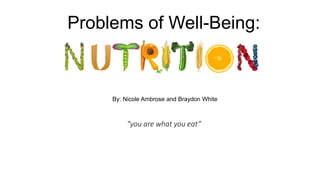
You Are What You Eat: The Importance of Nutrition
- 1. “you are what you eat” Problems of Well-Being: By: Nicole Ambrose and Braydon White
- 2. What is Nutrition? • Nutrition is the process of taking in nutrients from the foods you eat. • Your body needs six nutrients for energy, tissues and processes: - Carbohydrates - Fats - Proteins - Vitamins - Minerals - Water • Nutrients are substances that let your body make energy, build and maintain tissue and regulate bodily processes.
- 3. You are more likely to have good health if you are eating a healthy diet filled with high-nutrient foods compared to eating an unhealthy diet that is lacking in your nutrients.
- 4. Nutritional Foods look like…
- 5. Nutritional Foods DON’T look like…
- 6. What is Malnutrition? • A person that lacks the daily required nutrients, vitamins and minerals ones body needs is known as “malnourished”. • A malnourished person will find that their body will have a difficult time doing normal things such as overall growing and resisting sicknesses and diseases. • A malnourished person will also find that physical work becomes more difficult and even mental learning abilities can be diminished. • A women that is pregnant can run the risk of not producing nourishing breast milk for the baby. • Malnutrition is very closely linked to disease, “malnutrition is the largest single contributor to disease in the world”.
- 7. Causes of Malnutrition • Lack of food- More relevant in 3rd world countries, low income families and those of are homeless. • Too much food- While having a high calorie diet, you may be deficient in essential vitamins and minerals. • Lack of knowledge- With a lack of knowledge about nutrition, those tend of follow an unhealthy diet lacking nutrients, vitamins and minerals.
- 8. Causes of Malnutrition (Cont’d) • The demand the body needs for energy is greater then the amount of food taken in, this includes woman who are pregnant, causes an increased demand for nutrients and calories for the growth of the unborn baby. • Leading cause of malnutrition worldwide among children is the lack of knowledge of adequate feeding.
- 9. Controlling Malnutrition • While malnutrition can be controlled, in some people it cannot be. • Certain illnesses such as ulcerative colitis, Crohn’s disease and malabsorption syndrome which impair the bodies ability in assimilating the nutrients from the food. This leads your body to be vulnerable of being malnourished.
- 10. Living a Healthy Lifestyle • Nutrition is one of the most important factors contributed to our overall health and well-being. • Being on a proper diet and taking in the proper amount of nutrients and minerals your body needs daily leads living a healthy lifestyle. • Poor nutrition can contribute to number of health problems, some include, weakened immune system, Anemia, Heart disease and Osteoporosis. • Short-term affects of malnutrition may include, stress, tiredness, capacity to work and depression. • Unfortunately, many people disregard the importance of nutrition and therefore lack the proper nutrients their body needs to stay healthy.
- 11. Why is Eating the Right Nutrients Beneficial? • Protect, resist and fight infections in your body • Recovering from sicknesses • Boosting your immune system • Reduce risks for strokes, cancer, heart diseases and type 2 diabetes • Reduce blood cholesterol levels • Handling stress better • High energy levels • Good moods • Proper brain function
- 12. How to Make Eating Healthy a Habit • Begin to make small changes • Learn about new ways to eat by cutting back on foods that are high in fat, salt and sugar • Set measurable goals you know you are able to reach, long and short term • Aim for balance • Look for variety in all your foods, especially in fruits and vegetables • Practice moderation when it comes to not eating the healthiest foods
- 13. Is Eating Healthy the Same as Going on a Diet? • Eating health is NOT the same as dieting • Eating healthy is eating the right nutrients for your bodies well-being • It is about creating changes you can live with, enjoy and love for the rest of your life • Diets are always temporary • Some diets today lack in specific nutrient your body needs
- 14. Did you know… • 34% of people aged 65 and older in 2008/2009 were at nutritional risk. • 60% of people ages 12 and up do not consume five or more servings of vegetables and fruit each day. • Every sugary beverage a child drinks daily increases their odds of becoming obese by 60% • Doing 60 minutes of moderate to intense physical activities every day contributes to improved cholesterol levels, blood pressure, cardiorespiratory and mental health. • Vitamin C, D, B12 are some of the most important vitamins to our health. Statistics Canada. (2015). Heart and Stroke Foundation. (2015).
- 15. Now that you know the benefits, its time to start eating healthy.
- 16. References • Holmes, M., Mooney, L., Knox, D., & Schacht, C. (2016). Understanding social problems (5th Canadian ed.). Toronto: Nelson Education Ltd. • Willett, W.C., Stampfer, M.J. (2013). Current evidence on healthy eating. Annual Review of Public Health; 34, 77-95. • (2015). Overweight and Obesity. Centers for Disease Control and Prevention. Retrieved from: http://www.cdc.gov/obesity/index.htm • Statistics Canada. (2015). Nutritional Risk among Older Canadians. Retrieved from: http://www.statcan.gc.ca/pub/82-003-x/2013003/article/11773-eng.htm • Heart and Stroke Foundation. (2015). Statistics. Retrieved from: http://www.heartandstroke.on.ca/site/c.pvI3IeNWJwE/b.3581729/k.359A/Statistics.htm